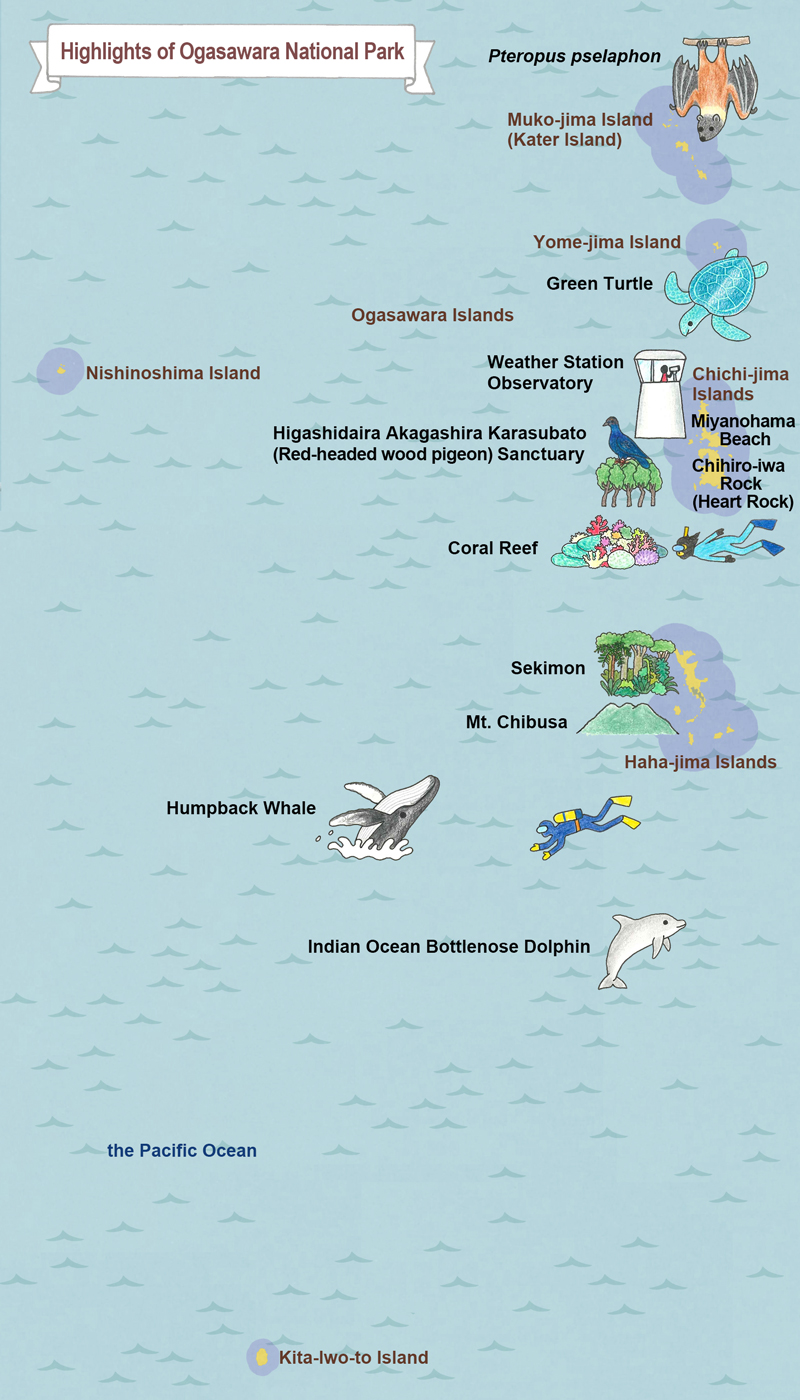- MOE
- National Parks of Japan
- Ogasawara National Park
- Guide of Highlights
main body
Highlights of Ogasawara National Park
Chichi-jima Islands
Anijima Island Marine Park
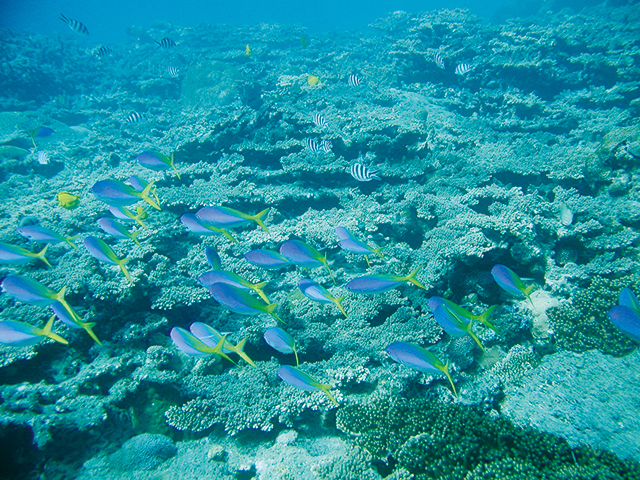
Anijima Island Marine Park
This coastal area on the south of Anijima Island is highly transparent where schools of multicolored tropical fish swim amongst coral reefs. Visitors can visit on a coastal eco-tour.
Miyanohama Beach

(c) Ogasawara Village
Miyanohama Beach
Miyanohama Beach is situated in the northern part of Chichi-jima Island. With Anijima Island positioned directly offshore, this beach is ideally located. Underwater coral reefs and a large variety of fish species appeal to snorkelers. As the rapid tidal currents further offshore are dangerous, refrain from going beyond the warning buoys.
Nagasaki Observatory
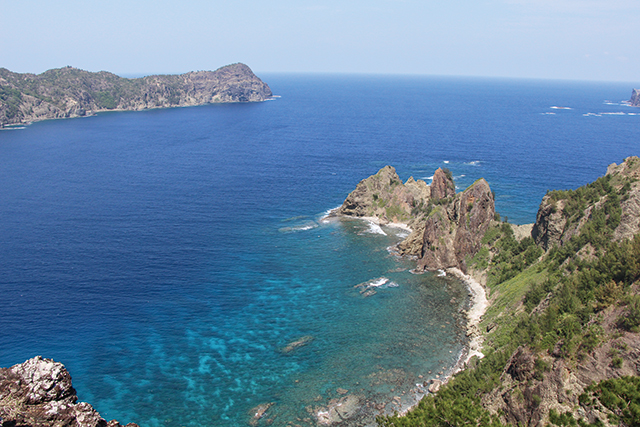
Nagasaki Observatory
Located at the end of the Mt. Denshin footpath, Washington Beach and Anijima Seto spread before your eyes along with the views of islands Seto.
Mt. Asahi
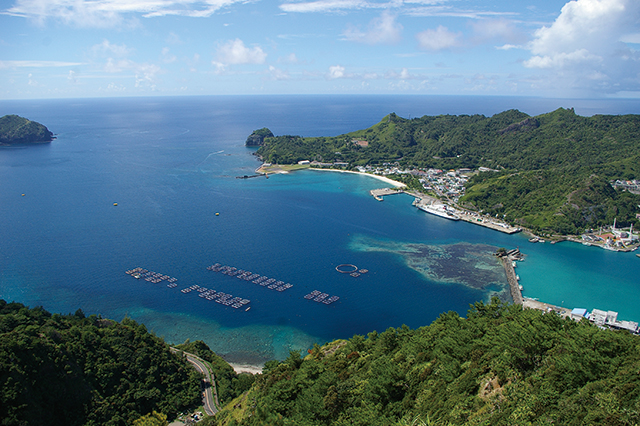
Mt. Asahi
With an altitude of 267 meters on the east of the Futami Port, visitors can reach the summit by foot in 30 minutes from the parking lot at the entrance. A commanding view of Futami Port can be enjoyed from the top.
Weather Station Observatory
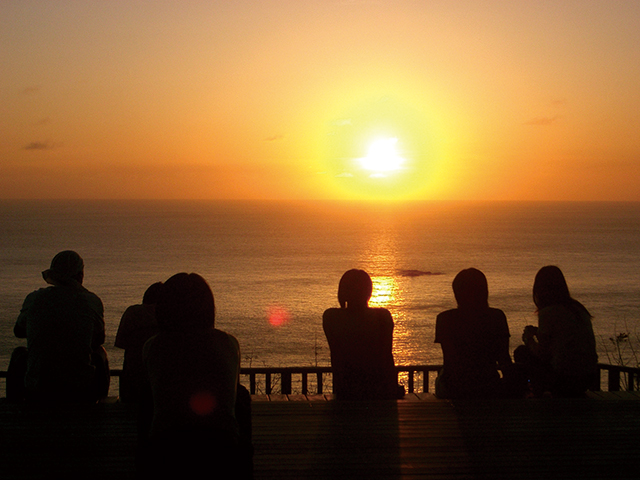
Weather Station Observatory
Situated on the west side of the Chichi-jima Island, this observatory is the best location to view the sunset sinking beneath the horizon where it is crowded with people when the weather is nice. Visitors can enjoy whale watching during the high season.
Higashidaira Akagashira Karasubato (Red-headed Wood Pigeon) Sanctuary
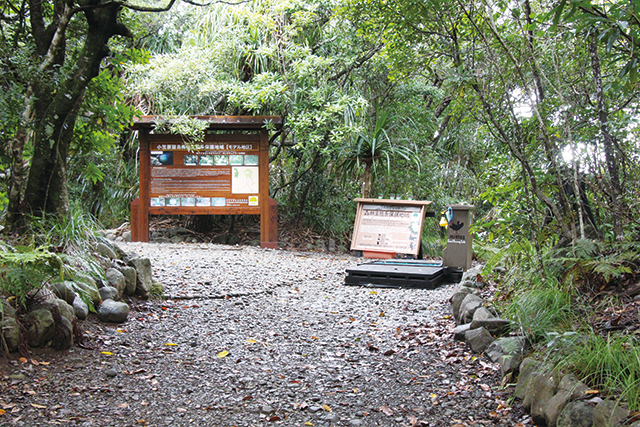
Higashidaira Akagashira Karasubato (Red-headed Wood Pigeon) Sanctuary
This area has numerous endemic and rare species including Columba janthina nitens. All visitors must be accompanied by Tokyo nature guides with an entry permit as it is a protected area of the forest ecosystem.
Kominato Beach
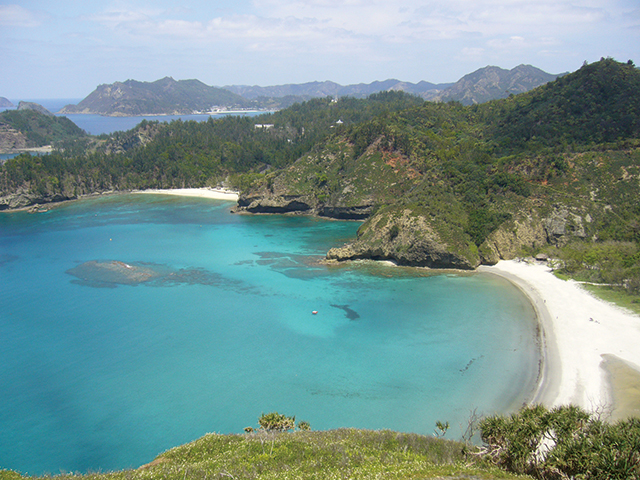
Kominato Beach
Once you come through a tunnel of maritime forest, white sandy beach spreads before your eyes. This calm shoaling beach is best for sea bathing. It can be accessed via a local bus.
Minami-jima Island
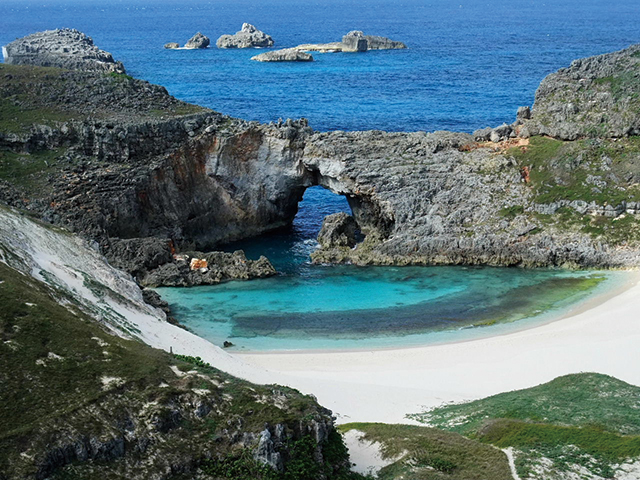
Minami-jima Island
The island is a good example of submergence karst topography consisting of limestone, and here visitors can behold beautiful views created by the breathtaking contrast between the white sand and the bright blue ocean. All visitors must be accompanied by guides certified by the Tokyo metropolitan government in order to be on the island.
Haha-jima Islands
Kita Port

Kita Port
The rest house roof is made of Chinese palms at the end of a north line toward the north. The bay on the other side is known as the best snorkeling spot. The area was the site of a northern village and the remains of an elementary school can still be seen.
Sekimon
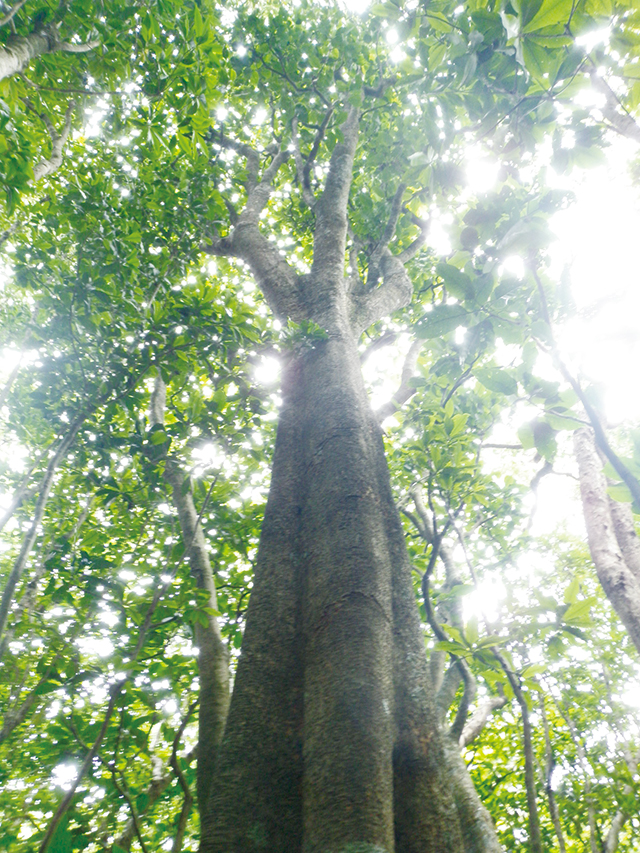
Sekimon
Here visitors can enjoy the atmosphere created by a dense hydrarch tall tree forest consisting of 20-m tall Pisonia umbellifera and Elaeocarpus photiniaefolius trees. All visitors must be accompanied by guides certified by the Tokyo metropolitan government.
Mt. Chibusa
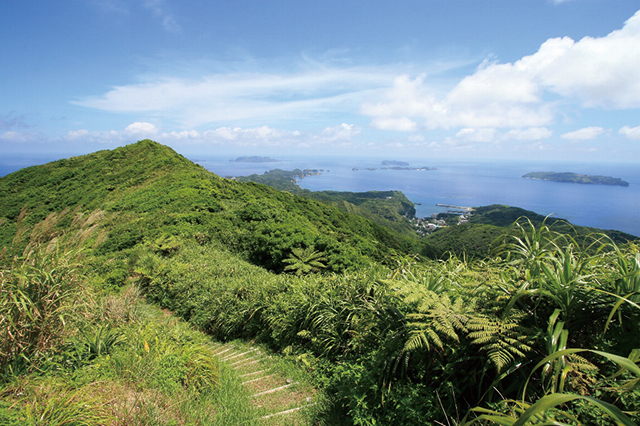
Mt. Chibusa
The highest peak in the Haha-jima Islands has an elevation of 463 m. When the weather permits, you can enjoy views of islands around the beautiful Haha-jima Islands. There are a number of endemic species including Melastoma pentapetalum along a footpath.
Miyukinohama Beach

Miyukinohama Beach
Designated as a marine park for its beautiful underwater scenery where the coral reefs grow, it is the best snorkeling spot. There are fossils of larger foraminifera called nummulite on the beach.
Minamizaki Beach

Minamizaki Beach
After going through a mildly undulating forest of Livistona chinensis and Pandanus boninensis, a beautiful beach with coral reefs expands before your eyes. Although it is a perfect snorkeling spot, it requires attention because the current is strong offshore.
Minamizaki-Kofuji

Minamizaki-Kofuji
The views of islands of the Haha-jima island chain can be enjoyed from Kofuji situated at the end of footpath in Minamizaki on the ocean side while the beautiful views of dry scrub forests spreading all the way to Mt. Chibusa can be enjoyed from the opposite side.
Chihiro-iwa Rock (Heart Rock)
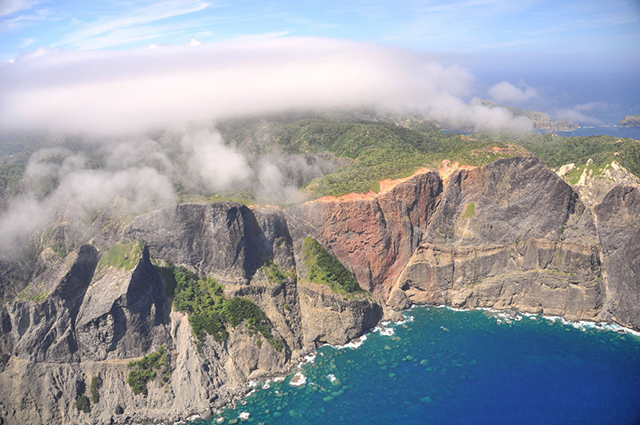
Chihiro-iwa Rock (Heart Rock)
A giant heart-shaped rock towering approximately 200 meters off the ground occupies a corner of the sea cliffs on the south shore of Chichi-jima Island. It is believed that laterite soil on the upper part of this formation was washed away by rains, thereby causing the rock surface to stain. This rock is a destination for many trekking tours. In winter, visitors can try and spot humpback whales swimming in the ocean from this vantage point.
Wildlife & Plants
Coral Reef

Coral Reef
Located in a mild subtropical zone, Ogasawara is home to many hermatypic corals. Snorkelers and divers can enjoy underwater landscapes created by the corals.
Green Turtle (Chelonia mydas mydas)

Green Turtle (Chelonia mydas mydas)
Green turtles are widely distributed throughout the tropical and subtropical zones of the world. In Japan, Ogasawara is an egg laying ground for the sea turtles, which may be encountered on sandy beaches during the breeding season. Voluntary rules have been established to prevent impacts on the green turtles.
Pteropus pselaphon
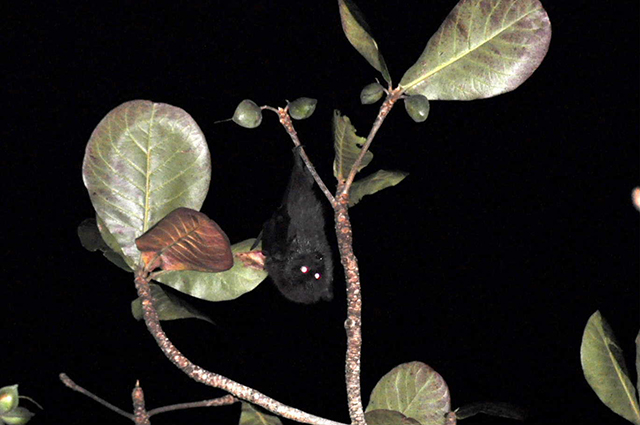
Pteropus pselaphon
The only mammal that is endemic to the Ogasawara Islands. It is sometimes referred to as the "fruits bat," because it mainly eats nectar from flowers and fruits of plants. Watching excursions are subject to rules calling for voluntary restraint when observing the animal, and night tours adjusted to the bats' nocturnal activity.
Indian Ocean Bottlenose Dolphin (Tursiops aduncus)

Indian Ocean Bottlenose Dolphin (Tursiops aduncus)
These dolphins inhabit warm coasts along areas including the west side of the North Pacific, the South Pacific close to Australia, and the Indian Ocean. Ogasawara is one of the leading dolphin watching spots in the world. Visitors can enjoy dolphin watching under voluntary rules established to prevent impacts on the dolphins and to ensure the safety of participants.
Humpback Whale (Megaptera novaeangliae)

Humpback Whale (Megaptera novaeangliae)
Ogasawara and the Nansei Islands are the main breeding grounds in winter. In Ogasawara, whale watching takes place under voluntary rules that can be called a forerunner of ecotourism.
Activities
Snorkeling

Snorkeling
Visitors can snorkel along the coast to enjoy abundant hermatypic corals, tropical fish, and underwater scenery.
Scuba Diving
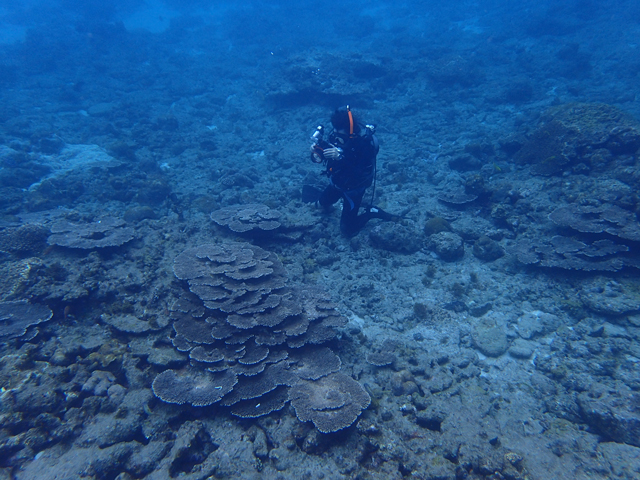
Scuba Diving
This is a diving method that employs tanks filled with air. Surrounded by the open sea, Ogasawara National Park offers the sight of dogtooth tuna and greater amberjack, as well as curtain-like schools of fish and colorful tropical fish.
